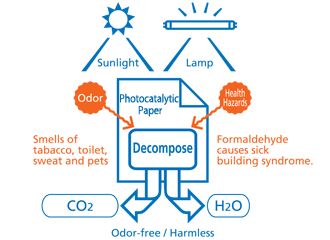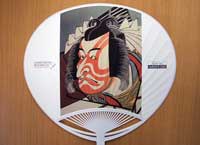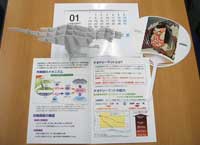|
AIR-PURIFYING PAPER
Calendars and Tissue Boxes That Help People Breathe Easier
(January 31, 2008)
|
|
We live our lives surrounded by all sorts of smells, and there is a wide array of products designed to eliminate the more unpleasant ones. Paper is the latest material to be given deodorizing properties, and the anti-odorant papers developed by Japanese manufacturers have so far met with positive reviews. One such material is photocatalyst-coated paper, which was made public in 2006 by major paper maker Nippon Paper Industries Co. The Science Behind Photocatalyst-Coated Paper The most common photocatalyst is titanium oxide, which is already used as an air purifier in things like construction materials and air conditioners. Photocatalytic paper, or paper containing titanium oxide, has been commercially available since before photocatalyst-coated paper was developed, but the titanium oxide in old-style photocatalytic paper is embedded in the paper's fibers, shading it from the ultraviolet light that it needs to mediate reactions. What is more, the oxidization-hastening effects of the titanium oxide degrade the paper itself. Nippon Paper Industries used what is known as an inorganic binder to overcome these setbacks. 
How photocatalytic paper works. (C)Nippon Paper Industries An inorganic binder is an inorganic substance with particles smaller even than titanium oxide. The binder is adhered to the surface of the titanium oxide, which can then be used to coat the surface of paper. This way the titanium oxide cannot easily degrade the paper because the binder prevents them from directly touching. It can still, however, come into contact with organic substances in the air through the small openings in the inorganic binder, enabling it to exhibit its air-purifying effects. Advantages Over Other Deodorizers In light of these advantages, Nippon Paper Industries is putting PCP to a variety of uses. It teamed up with the Yomiuri Shimbun newspaper in 2005 to produce a special advertisement supplement printed on photocatalytic newsprint. The use of this unique paper is spreading, with financial institutions, food companies, and other enterprises putting it in their calendars to drive home an image of cleanliness, and paper companies using it to make their tissue paper packaging. |
Copyright (C)2008 Web Japan. Edited by Japan Echo Inc. based on domestic Japanese news sources. Articles presented here are offered for reference purposes and do not necessarily represent the policy or views of the Japanese Government.

